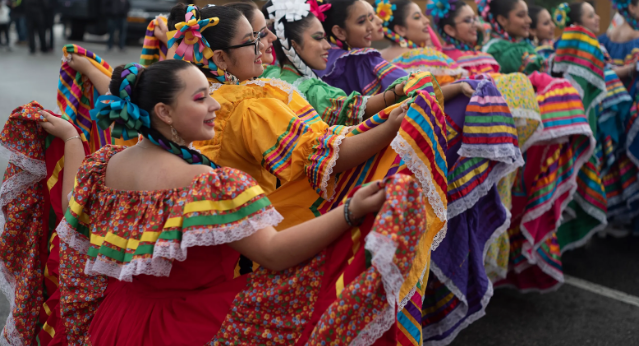Feature Photo By: Luis Ramos- LULAC Club students are creating flags of their choice that represents who they are. LULAC meets nearly every Wednesday in the CCC from 3:30-4:15 and is open to all students.
Take a look around, and one might observe a strong mixture of races all around Rangeview. Nonetheless, one of the most noticeable changes has been the increase of Latino students at Rangeview. Students and staff at Rangeview speculate that there’s been a noticeable rise over the years in that specific community.
When the numbers are shown, the statistics reveal that the eyes of students and staff weren’t playing tricks on them, the Latino community has, as a matter of fact, grown at record scale. It’s been occurring over the years and mainly in recent ones.

In the school year 2004-05 at Rangeview, the Latino community was at 20%. Today, this group makes up over ⅓ of the population with an amount of 39% which displays a change of nearly 20% in a matter of 12 years.
According to Mr. Fay, the white student population was the largest at Rangeview with a total of about 90 to 95% when it first opened its doors in the fall of 1983. Currently, the white student population is down to 25%.
“Honestly it doesn’t make a difference, we’re all hear to study and go to college, but it is good to see different races coming in… this [growth] was going to happen because a lot of Hispanics are trying to have a future, they’re just trying to get an education and move forward,” said Angel Celedon, a junior at Rangeview.
Nevertheless, the mystery between what caused such an increase continues to grasp the attention of the community at Rangeview. Truth is, there is no exclusive answer but numerous alternatives.
Ann Atencio, a counselor and leader of the LULAC club at Rangeview states that LULAC is a true college/academic focused club, yet it is only one of the many things that has helped Latino students at Rangeview become larger as a community. Atencio agrees that some extra support is always a great thing considering even the minor things can cause a significant impact.
Atencio said, “I’ve been sponsoring LULAC for the past seven years and the reason why is because our graduation rate for Latino students was one of the lowest and not just at Rangeview but in the district.”
The counseling department has also contributed to this change by creating something they call “Closing the Achievement Gap”. It is a goal that the counselors set and make it essential to meet by the end of every year; some of those years they focused a lot on helping Latino students.
In order to accomplish this goal for this category of students, Ms. Atencio and other counselors worked with ELD teachers since a great deal of the students were Hispanic. The ELD teachers were advised to give more ACT prep because the students revealed how much they wanted to go to college.
Another striking cause for this impact were the Latino cultural family nights at Rangeview where part of the staff got to meet the parents of the students and learned more about their world perspectives. The parents were also given English classes at Rangeview, all of which created a considerable outcome because it made Rangeview so much more welcoming.
In sum, the effects were clear with the help of every step taken throughout the building. There has been a rise in scholarship awareness, more Spanish speaking staff appeared over the years, and the graduation rate improved tremendously as well for this group of students.
Undoubtedly, the Latino community did not simply flourish without warning, it was encouraged when RHS began meeting the needs of every kid and family.
Fore further information on ethnicity statistics and other demographics at Rangeview and other APS visit:






